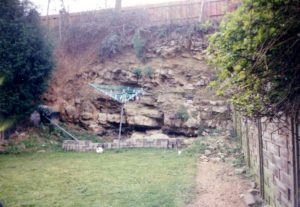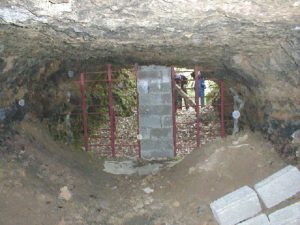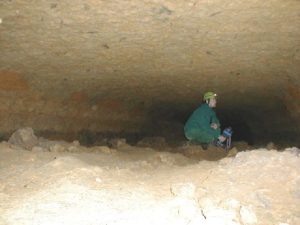Limestone is not generally associated with the South East but there are two types found in Kent and Sussex, which have been quarried and mined in the past.
Ragstone
This deposit occurs in the Greensand Beds and is variously described as ’limey’ sandstone or a ‘sandy’ limestone (the latter term being more correct). It is found in the area around Maidstone and Westerham and was used in the past as a building stone. Local deposits were in fact used by the Romans to construct the walls of London and it was later used in the Tower of London, St Paul’s Cathedral and Rochester Castle. Large quarries existed around Maidstone and it is known to have been mined in at least three locations in the vicinity of Mote Park. These seem to have been underground extensions of surface quarries but the latter two sites have now been built upon. None of the mines are believed to be accessible now.
The mines at Hosey Common, Westerham are believed to date from the 17th century but little is known of their history at present. Again, they produced building stone and this was used for Westerham Church. They lie on the side of a shallow valley and the area is now heavily wooded. Four separate sets of workings have been identified and it is believed that more exist but are inaccessible due to roof falls. The mines were worked on the pillar and stall principle and the original passages were up to 7ft high by 8ft wide. Transport underground was by sledges and excavation in the floor has revealed sledge marks with a gauge of 14.5ins.
At some time in the past, however, the passages were backfilled with waste rock and this has only left a gap of a few feet. It is believed that this was carried out at a time when the price for the stone dropped drastically and the only economical way of working was to extract the best quality stone only. This meant that a great deal of poorer quality rock was no longer required and it was more convenient to stack it in abandoned passages rather than carry it out of the mine.
These mines have suffered several roof falls in the past and they are a maze of passages so exploration by inexperienced persons is not recommended. In addition, they are the most important hibernation sites for bats in S.E. England so the entrances have been grilled to prevent unauthorised access. See the Kent Bat Group Website.
Purbeck Limestone
This is found as a deposit in Sussex where it forms a type of island called an ‘inlier’ in the middle of other strata. Unlike Carboniferous Limestone, which can be a solid mass over 1,000ft thick, the Purbeck Limestone consists of a number of thin beds of limestone mixed with beds of shale. Collectively they are separated into two main deposits, the shallower ‘Greys’ and the deeper ‘Blues’.
Some of the limestone was used for building purposes in the past when it was given the name of ‘Sussex Marble’. A reference in 1860 indicates that it was mined somewhere near Street Green and Ashdown but research has yet to reveal the site of these excavations. Although such stone could be quarried, it was often found that surface deposits were too broken up to make large blocks and thus the deeper deposits were obtained by mining.
The largest concentration of limestone mining, however, took place in a rough triangle based on 3 large inliers at Archer Wood, Limekiln Wood and Rounden Wood. Although some of this was used as roadstone, the majority was burnt to produce agricultural lime to enrich the poor soil of the surrounding area. The earliest method of extraction, and one which was used in places right up to early this century, was to mine the ‘Greys’ by sinking bellpits. These were similar to deneholes and were described by a contemporary visitor to the area.
‘The bell-pits, where of any depth, require 5 men to sink them, two remaining at the windlass while the others work below. A circular shaft, 4ft in diameter, is sunk for 20ft. The quarrymen then commence to bell it out, increasing the diameter with depth, so that eventually the base of a pit, 50 – 55ft deep, is as much as 20ft across. No timbering is necessary unless, as is sometimes the case, the quarrymen proceed to drive out horizontal galleries from the base of the pit. The amount of water in these pits is rarely great and pumps were seldom erected; but pinnocks, or square timber troughs 8 inches square, were laid down from one pit to another and so continued to lower ground.’
The term ‘quarrymen’ may be confusing to the reader but it was a term used in the South East to describe men who extracted stone either from quarries or mines. Some of the larger stone mines were in fact termed underground quarries and this has caused no end of confusion to researchers looking at old records! The mention of ‘pinnocks’ is also interesting since it suggests that adjacent bellpits were connected underground, whereas the usual procedure was to keep them separate. In this particular area, the bellpits were usually sunk on the sides of valleys and the collapsed shaft hollows and spoil heaps can still be identified, although now planted around with trees. Examples can be seen to the west of the public footpath which descends to the River Dudwell from Poundsford.
This small-scale mining could not keep pace with the demand for lime and the Earl of Ashburnham, who owned much of the area, devised a revolutionary plan to solve the problem. It was known that better lime could be obtained from the ‘Blue’ limestone but this was at a greater depth and bellpits could only produce a relatively small amount of limestone for the effort involve. What was required was a larger scale mine but there was no local expertise to operate one. It was easy to sink a shaft and dig out small chambers but special skills were needed to drive levels and excavate limestone in an efficient manner. Thus in 1786 the Earl engaged a mining agent from Derbyshire called Anthony Tatlow. Derbyshire was chosen because of its many lead mines in which the miners had to excavate limestone to get at the ore.
Tatlow was given the job of setting up a system for mining the ‘Blue’ limestone and burning it to produce sufficient quantities of lime for the area. He selected Orchard Wood (subsequently corrupted to Archer Wood by the Ordnance Survey) for the first mine and teams of Derbyshire lead miners were brought down on contract to develop it. Over the years, a number of miners came back to work in Sussex and, after a year or two, had earned enough to return to buy their own mine. Some, however, carried on for many years and it is possible that descendants of these miners still live in the area. Old records indicate that the Earl took particular trouble to look after the welfare of his miners, something that was not common in those days. As well as housing, he paid for any medical treatment required following accidents in the mine and on several occasions made ex-gratia payments to miners unable to work due to injury. The mine and lime works grew to such a size that they became a small community in their own right with a number of ancillary workers such as road menders, woodcutters, tailors and even a mole catcher!
These miners were fiercely independent and brought with them their system of ‘Bargains’ for working the mine. They were formed into teams of 2 or 3 and every month would negotiate with the Mine Agent a price per cubic yard of stone brought out of the mine or yard of shaft sunk. This was a gamble and success depended on how easy it was to excavate the limestone, since they were not compensated for bad luck such as hitting unstable areas. The mine was divided into several areas of work, each of which could be bargained for by any of the teams in a process similar to an auction. It suited the Mine Agent because it was in the interests of the teams to extract as much as possible. At the next monthly agreement (or Bargain), either side could negotiate a new price to take account of conditions. If conditions were easy and a great amount was being removed, the Mine Agent might reduce the price for a particular area by offering it to the team willing to work for the least amount. If conditions were difficult and none of the teams was interested, the Mine Agent would be forced to increase the price to allow for the reduction in output and earnings. The system was popular with the mineworkers since, despite the risk, large earnings were possible. Two contemporary accounts give an insight into the methods of working.
‘ . . . they commenced by sinking a main pumping shaft . . . and at a depth of 60ft two levels were driven out to the right and left . . . These, which were called the Wet Levels, constituted the southern boundary of the workings and served to drain the whole of the excavations subsequently made. Two pumps were mounted in the main shaft and were driven by the power derived from an overshot waterwheel. The whole length of the levels was divided into distinct faces of work, by means of galleries driven out at right angles to them, and subsidiary shafts were sunk for the purposes of winding up the stone. A face of work was then gradually carried forward, the miners supporting the roof as they advanced by means of forks or upright timbers with cross props, the limestone being brought to the foot of the shaft along the gallery, while the shale and refuse portion of the stone was thrown back into the ‘gobbin’ behind. When the distance of the last face of work from the level had reached the limits beyond which the stone could not be drawn with economy, a second face of work was treated in a similar manner and the operation repeated until the whole had been advanced to equal distances from the main Wet Levels. Levels were then driven parallel to the first two, a second series of shafts sunk, and the extraction of the stone recommenced . . . Eventually a third series was sunk . . . Only the 1st, 2nd and 3rd limestones were extracted at first, the 4th being left to form the roof when the 5th and 6th were extracted, the height of the galleries in the first case was 5ft/ in the second 4ft … With respect to the galleries, care was always taken to keep one side of them, while in use, protected by firm unbroken ground; the hard refuse, stone, etc. was packed in to form a wall upon the other.’
‘ …The shaft by which we descended is 4ft by 5ft, boarded, with ladders for the men to go and return from their work, which is 80ft deep more or less; through this the stone is drawn up in barrels of 5cwt to each, one descending while the other ascends. The whole machinery is moved by a horse and is the same with that generally used in collieries . . . The process in separating the limestone from the solid bed is to blast it with gunpowder; a hole is bored in the rock with an auger; a pricker is put into this whilst the powder is rammed down and, when this part of the operation is finished, the pricker is taken out and a wheat straw filled with powder is put into the place of it, and a small piece of touch paper to the top of the straw, so as to communicate with the powder within, and give time to the workmen to seek a place of safety. When the rock is blown up, the stone rolls down in large blocks, which are broken to a portable size and then conveyed in barrows or little wagons, on roads framed for the wheels to roll along, to the foot of the shaft. A boy fills the bucket, which is drawn up and stacked into square yards.’
The surface of the mine is on a steep valley side and the limestone deposits rose at a lesser angle. Thus the shafts became deeper as the workings proceeded away from the valley bottom, the lower shafts being 60ft deep and the upper ones up to 120ft deep. At these depths, it was impossible to wind stone up by hand and thus a device called a horse gin was used. This was a large horizontal winding drum, pivoted in the centre and turned by a horse. The other interesting reference is to the pumps operated by a waterwheel (the only known use in a mine in the South East) which was fed with water from surface dams. The circular motion of the waterwheel would be converted via a crank to back and forward motion using lengths of connected timber called flat rods. A pivot at the shaft would convert this to up and down motion using flat rods which would operate the pumps at the bottom. Water would be raised in pipes to near the shaft top where it would be directed down a small level to emerge next to the stream. Old references indicate that the waterwheel itself may have been installed underground in a chamber near the top, a procedure used in Derbyshire mines. At surface, the stone from the mining teams was kept in separate places to enable the monthly reckoning to be done. From here it was taken to the nearby kilns to be burnt into lime, using faggots of brushwood cut from the abundant woodlands surrounding the works. The mine produced large quantities of limestone for over 30 years until the miners came up against a geological fault which stopped operations.
There are a number of surface remains identifiable at Archer Wood but some are difficult to find since the whole area has now been planted with trees. Intending visitors should note, however, that the mine area is on private land and permission should be sought before venturing away from the public bridleway. There is a system of three dams (A), (B) and (C) which were used to retain water to operate the waterwheel for pumping. At the second dam, a brick conduit carried water under the track but it has collapsed on the downstream side. From the bottom dam, the leat (D) can be followed as it hugs the contours to retain its level and thus provide a sufficient head of water to operate the waterwheel. In the wood, on either side of the track, are the hollows of the winding shafts (E) which appear to have been filled in. These shafts stop near the top of the valley side where the line of the geological fault can be traced. The pumping shaft (F) is near the valley bottom and the collapsed drainage tunnel (G) is nearby. A deep channel has been cut from its mouth to allow water to flow into the stream. From the pumping shaft, an old track can be followed downstream to where the lime burning was carried out. The remains of two Flame Kilns (H) can be seen to the right of the track and the Tunnel Kiln (I) further down on the left. The history of this interesting mine is being researched in great detail by members of the Kent Underground Research Group and will be covered in one of their future publications.
Soon after the Archer Wood Mine was set up, the Earl of Ashburnham authorised another one at Dallington Forest. Although this was known as Forest Mine, it actually consisted of three separate adjacent mines at Scotsham, Poundsford and Westdown This complex soon came to rival Archer Wood for output and it is believed that it carried on long after Archer Wood ceased operations. The lime produced by the Earl’s mines soon came to earn a favourable reputation for quality and it was actually shipped from Hastings to London where it was in demand for making mortar.
The success of the lime works soon tempted the Earl’s neighbours to start similar schemes and there are references to other limestone mines in the area. Although the exact locations have yet to be identified, they are at Willingford, Brightling, Darwell Road and Hurst Green. It is not known if these mines were on the same scale as those of the Earl of Ashburnham but skilled miners would certainly have been available who had obtained their experience at the Earl’s mines.


